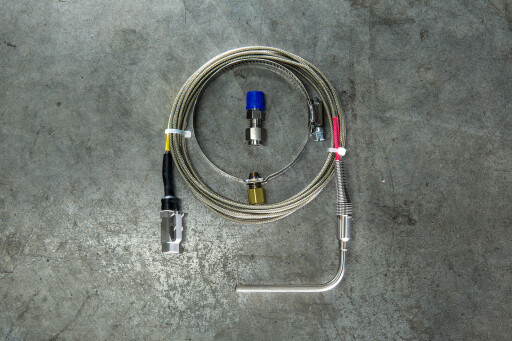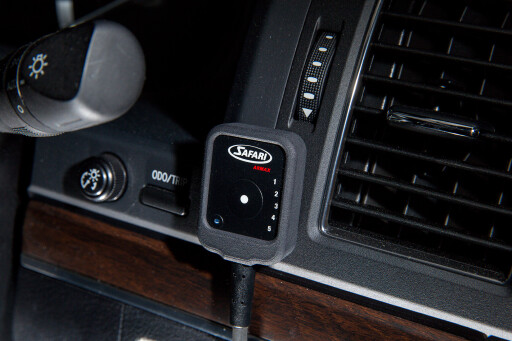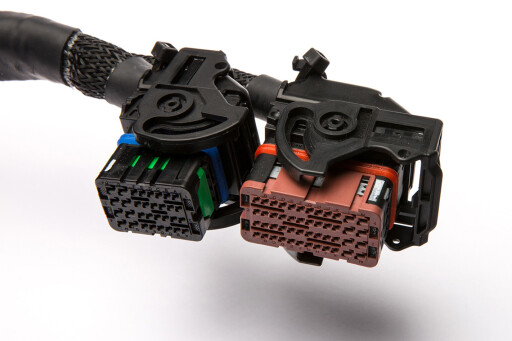
SAFARI has launched its innovative and sophisticated Armax Performance ECU system.
One hundred per cent designed and manufactured in Australia, the all-new ECU system utilises M1 technology and, generally speaking across most applications, can safely hike power by 20 to 25 per cent and torque by 30 to 35 per cent.
The state-of-the-art system is packed with a number of key features – none more important than its IP68 rating, making it impervious to dust and water (and operable at one metre underwater). However, there’s no point having an IP68-rated unit if the wiring loom, connectors, terminals and caps are susceptible to water and dust ingress.
 “Obviously, if we were going to make a unit that was IP-rated then we had to have every other part of the system be equivalent, otherwise we have a weak link,” said Duane Evans, Safari’s Engineering Director. “All of the connectors in our wiring system are IP-rated, the cable is IP-rated, and the terminals are all full-machine crimped, which are all individually pull-tested.
“Obviously, if we were going to make a unit that was IP-rated then we had to have every other part of the system be equivalent, otherwise we have a weak link,” said Duane Evans, Safari’s Engineering Director. “All of the connectors in our wiring system are IP-rated, the cable is IP-rated, and the terminals are all full-machine crimped, which are all individually pull-tested.
Transmission remapping explained
We have dual-layer protection like an OE wiring loom does, and even the communications cable has an IP-rated cap on it.” Safari expects the wiring loom to last the life of the vehicle, and the same can be said of the bracketry which is supplied with the kit as standard. “The bracketry is vehicle-specific, the same as the wiring loom,” Evans said.
“It features stainless steel hardware and dual-layer corrosion protection which includes zinc-plating and powdercoating.” Of the unit, Evans added: “Part of the unit’s make-up is a billet aluminium base that’s designed to act as a heat sink, so we can control the temperature very accurately inside the ECU.”
 Another integral part of the ECU system is the unit’s Exhaust Gas Temperature (EGT) control, which constantly monitors temperatures at all times. “EGT control is standard on every kit and it’s one of the key features the unit offers,” explained Evans.
Another integral part of the ECU system is the unit’s Exhaust Gas Temperature (EGT) control, which constantly monitors temperatures at all times. “EGT control is standard on every kit and it’s one of the key features the unit offers,” explained Evans.
“Excessive EGT is a killer for diesel engines; it’s like detonation to a petrol engine. It will kill that engine in a short space of time, or its lifespan will be significantly reduced.”
By monitoring EGT, the system will protect the engine if temperatures are rising at an unsafe rate, but, as Evans told us, “in general everyday driving you’ll never experience the EGT system working – it’ll constantly be working, but it’ll never actually do anything except in rare circumstances”.
The unit’s map selection switch has been carried over from the original unit. However, the major difference with the new unit is that it can now be operated from inside the cabin rather than from under the bonnet, for added convenience and accessibility.
 In addition, the map selection switch is illuminated with a light sensor, so when it gets darker it will reduce in its illumination; but during the day it will have a bright glow. With the new map selection switch, customers can also shift through the map settings – Comfort, Towing, Off-Road, Sport and Standard/User-defined – on the fly.
In addition, the map selection switch is illuminated with a light sensor, so when it gets darker it will reduce in its illumination; but during the day it will have a bright glow. With the new map selection switch, customers can also shift through the map settings – Comfort, Towing, Off-Road, Sport and Standard/User-defined – on the fly.
Those familiar with Safari’s previous ECU unit will notice the new unit features two more map positions. A high ECU processing speed is another strong suit of the new unit, as is Safari’s ability to live-record and data-log a 4x4 – “so if a person is stuck somewhere and something’s happened, we can actually assist them,” Evans added.
A system is also in place to prevent a vehicle from billowing dreaded ‘black smoke’. There’s the potential for a vehicle to exert black smoke when increasing fuel into an engine, so to combat this Safari monitors the system and adds extra air accordingly.
“We also have the ability to ramp in the fuel as the boost is increasing. So instead of just chucking it all in there and hoping for the best, we’ll progressively add fuel to prevent that initial puff of smoke.” Evans added. To be completely satisfied with the end product, Safari carries out its own fuel consumption testing, primarily in a controlled vehicle and within controlled parameters.
 “We drive controlled routes with the same driver in excess of 10,000km. And we see on average a 1.0 to 1.5L/100km gain in fuel consumption,” Evans said. “You get more power and torque and better driveability, but you also use less fuel at the same time.”
“We drive controlled routes with the same driver in excess of 10,000km. And we see on average a 1.0 to 1.5L/100km gain in fuel consumption,” Evans said. “You get more power and torque and better driveability, but you also use less fuel at the same time.”
The plug-and-play unit comes with everything required for installation, including bracketry, nuts and bolts, and plug-and-play looms. And each unit is vehicle specific and will bolt factory mounting points, with no drilling required. Safari 4x4 also keeps in mind common devices usually fitted beneath the bonnet of four-wheelers and incorporates this into the design.
Evans told us that installation is relatively straightforward and DIY jobs are a breeze. “If you’ve got some basic tools and good general mechanical knowledge, and you’re prepared to take your time and follow instructions, you could easily install it at home,” he said.
The Armax Performance ECU system will initially be available for Toyota’s 70 and 200 Series – specifically Euro 4 and Euro 5 variants – but Safari expects to have a product range of 20 different applications within 12 months. “The next models will be Ford Ranger (estimated arrival by the end of 2017), Mazda BT-50 and Ford Everest.
 The product range will then extend to Amarok, Navara, D-Max and Colorado.” Arrival dates at this stage are tentative, because, as Evans stated: “Unless it’s perfect, it ain’t going out the door.” It’s this attitude which guarantees customers of Safari peace of mind, with the knowledge that its unit will last the life of the vehicle it’s fitted to.
The product range will then extend to Amarok, Navara, D-Max and Colorado.” Arrival dates at this stage are tentative, because, as Evans stated: “Unless it’s perfect, it ain’t going out the door.” It’s this attitude which guarantees customers of Safari peace of mind, with the knowledge that its unit will last the life of the vehicle it’s fitted to.
“We’ve spent months testing sensors, testing connectors, testing parts, so that we know it’ll last,” Evans said. “I’ve been driving one of the cars for months now and with more than 20,000km clocked up to ensure that every possible scenario is taken care of.”
The first customers who pre-ordered the unit received it on October 23. For more information, or to order one, head to www.safari4x4.com.au. Pricing starts from $2997 (RRP inc. GST). Customers get peace of mind with full engine protection and component warranties.
We’ll be taking an LC79 and LC200 to some dusty trails next month to put Safari’s Armax Performance ECU unit to the test. So stay tuned.
WHAT’S IN A NAME?
The Armax branding, implemented by Safari about three years ago, isn’t solely related to one particular product (snorkels); instead, it stretches to a variety of 4x4 products.
As Duane Evans, Safari’s Engineering Director, explained: “Safari Armax is Safari’s performance range of products for 4x4 vehicles, and that could encompass snorkels, exhaust, intercoolers, turbocharger kits and, of course, engine management.”
M1 TECH
“M1 is a suite of tools that a company can use to make a control system operate however they want, generally with a focus on engine control,” Evans explained.
 “But it has the ability to operate a transmission, a suspension system... a whole bunch of things. “We use these tools to make our own unique platform, and that’s the Armax ECU.”
“But it has the ability to operate a transmission, a suspension system... a whole bunch of things. “We use these tools to make our own unique platform, and that’s the Armax ECU.”
REALISE THE POTENTIAL
To maximise the potential of your 4x4, Safari advises to recalibrate the system after other aftermarket components are installed (i.e. a snorkel or exhaust). If you’ve installed a snorkel, it’s simply a matter of downloading a preconfigured map to recalibrate the ECU.
.jpg ) This is simply done by your local Safari dealer or Armax reseller for a drive-in/drive-out solution. “If I go and fit an Armax snorkel on the vehicle, it makes a small increase in performance. If I then recalibrate the ECU to match the extra air intake, I then optimise that component fitted to achieve the best possible gain,” Evans said.
This is simply done by your local Safari dealer or Armax reseller for a drive-in/drive-out solution. “If I go and fit an Armax snorkel on the vehicle, it makes a small increase in performance. If I then recalibrate the ECU to match the extra air intake, I then optimise that component fitted to achieve the best possible gain,” Evans said.



COMMENTS